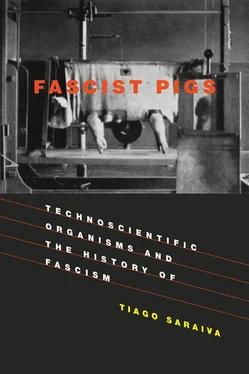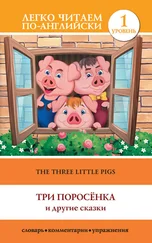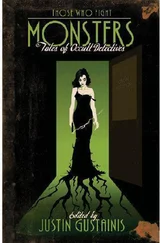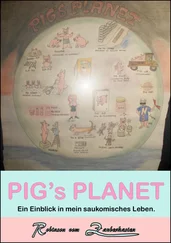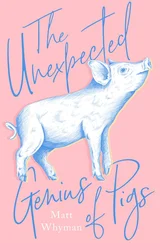As the expanding literature on the “cultural history of heredity” has eloquently demonstrated, focusing on organisms doesn’t imply a narrowing of historians’ perspectives, having led instead to an appreciation of the “economic and social preconditions for the coming into being of genetics, such as the beginning of agro-industrial mass production of organic raw materials and foodstuffs, as well as of drugs and vaccines, toward the end of the nineteenth century.” [58]This body of scholarship suggests that the history of model organisms and that of industrialized organisms go hand in hand. [59]To illustrate this, it suffices to point out that two basic concepts of the new science of genetics at the beginning of the twentieth century, the “pure line” and the “clone,” were direct products of breeders’ practices. [60]The “pure line” will have a prominent presence throughout the present book because of its role in forming the modernist belief in the unlimited human ability to tinker with life.
By the late nineteenth century, a growing number of breeders were rambling around farmers’ fields, identifying interesting plants, and reproducing them through self-fertilization, carefully documenting the characteristics of the progeny. [61]Through this so-called pedigree selection, breeders produced what Wilhelm Johannsen would famously call “pure lines”—alleged homozygotic stable varieties selected for some important feature such as pest resistance, early ripening, or milling properties. [62]They then combined different properties by crossing different pure lines to obtain the hybrids that made them famous in the seed market. Whereas chemists demonstrated their demiurgic power by creatively combining elements to produce new compounds, breeders promised endless innovation in the production of living things by hybridizing pure lines. [63]
A significant point that comes out of the history of breeders’ practices is the problematic relationship between science and technology in different contexts for the historical actors in question. [64]The gives and take (intermediated by market dynamics) between scientific experts equipped with the modern tools of genetics and practical breeders basing their decisions in allegedly traditional modes of classification has been particular prominent in the literature. [65]All the organisms I deal with in this book were domesticated animals and plants, and I will follow the processes through which they became scientific objects, mainly through the extended use of recording practices by academic breeders, and how these processes contributed to their industrialization. In the case of Karakul sheep, the blurring of the scientific and the technical was more evident. As sheep were being standardized for the production of fur coats, scientists also used them to illuminate more general properties in development genetics: they were simultaneously industrialized organisms and model organisms. The notion of technoscientific organisms tries to capture all these nuances: technologies of organism production that were changed through scientific practices, or science-based technologies; scientific practices that built on non-academic breeding techniques, or technology-based sciences; and plants and animals that were both industrialized and model organisms, or technoscience.
This book draws heavily on previous histories of the breeding of plants and animals in taking seriously the “complex interplay of social and biological considerations in organismal design.” [66]But, again, it insists that it is not enough to talk of a generic process of modernizing life production, because to do so misses the particular forms modernity assumed in different historical contexts. Pure lines and hybridization demanded recording practices first associated with seed companies and later with state-funded agricultural experiment stations. The need for a meticulous track of progeny, central to the new science of heredity, has thus been rightly associated with such general trends as bureaucratization, standardization, industrialization, and commercialization—in one word, modernization. [67]Less noticed are the alternative modernities that standardized forms of life have helped constitute. To put it bluntly, it would be misleading to treat as residual effects the contributions of breeders’ creatures to capitalist relations of American liberal democracy, to sustaining communist forms of production in Soviet Russia, or, as this book argues, to informing fascist sociability across Europe. [68]If above I called attention to the somewhat naive accounts of science and technology in general historians’ discussions of modernity, here I am pointing at the need to complicate the notions of modernity used by historians of science and technology. A persistent notion that permeates most narratives is that the rise of Mendelian genetics in the early twentieth century went hand in hand with the industrialization and commodification of organisms, leading to corporate or state control of life—something that alienated people in general and peasants in particular. [69]In such grand narratives, concrete political regimes are minor details of a more general process of modernization. This reminder is particularly important in a text dealing with fascism. Adorno and Horkheimer had famously equated capitalism and fascism through their analysis of instrumental reason in Dialectic of Enlightenment . [70]In California the two exiled philosophers from Hitler’s regime not only denounced the totalitarian dimensions of the Enlightenment tradition, scandalously perceiving in the French revolution a precursor to Nazism; they also urged intellectuals to uncover how fascism was present at the heart of Western democracies, including the United States. Since then, scholars inspired by critical theory have been justifiably eager to denounce the dangers associated with biopolitics in democratic societies. [71]But it is not because both fascist and liberal democratic regimes undertook biopolitics that they became indistinguishable. It is not because both standardized life that they became identical. [72]The thesis I put forth in this book is actually the opposite: that the increasing ability to tinker with plant and animal life—my extended version of biopolitics—enabled the materialization of different political projects, alternative modernities, good and bad, fascism being clearly among the bad ones. [73]
Differences are erased in ahistorical analyses limited to signaling the occurrence of biopolitics. One has to engage with the actual history of technoscientific organisms in order to understand the different nature of the newly formed social collectives. As a case in point, as this book details, animal performance records developed by academic breeders were being used in the 1930s in New Deal America and in Nazi Germany to make decisions about pig breeding, but while these practices led to leaner animals in the United States, they led to fatter ones in Germany. Leaner American hogs increased the market value of farmers’ produce through their higher protein content, thus avoiding the growing competition with cheap fats from vegetable origin. American standards measured the value of animals in a capitalist society, saving farmers from the Depression. Fatter German animals were to contribute to the Nazi autarky effort by reducing the need to import vegetable oils and by producing fat from national sources. German standards measured the contribution of animals to the national community. And pigs were not only expected to cover the German national fat deficit; they also had to be fed on potatoes and beets from the national soil. They had to be bodenständig (rooted in the soil)—a major concept guiding animal breeders in the Nazi regime, “Blood and Soil” ideologues, and Martin Heidegger, the philosopher who infamously asserted that rootedness in the soil distinguished the German Volk from uprooted Jewry. [74]In the years after World War I, scientists’ new standards allowed fascist ideologues to imagine a national community thriving on the productivity of the national soil and settling new territories—a bodenständig community. After seizing power in 1933, the Nazis would put in place a mammoth state structure—the Reichsnährstand—to see to it that only animals and plants complying with bodenständig standards were to be reproduced. Pigs not contributing to the feeding of the national body through the national soil were to be eliminated, as in fact progressively happened in the Nazi years. Only fat bodenständig pigs were fascist pigs, and they were the only ones that deserved to be part of the new fascist collective.
Читать дальше
